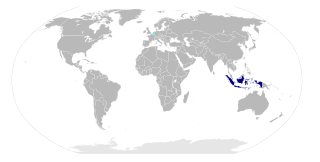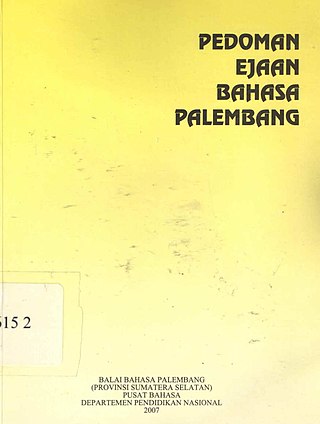
Indonesian is the official and national language of Indonesia. It is a standardized variety of Malay, an Austronesian language that has been used as a lingua franca in the multilingual Indonesian archipelago for centuries. Indonesia is the fourth most populous nation in the world, with over 279 million inhabitants of which the majority speak Indonesian, which makes it one of the most widely spoken languages in the world. Indonesian vocabulary has been influenced by various regional languages and foreign languages. Many borrowed words have been adapted to fit the phonetic and grammatical rules of Indonesian.

Jawi is a writing system used for writing several languages of Southeast Asia, such as Acehnese, Banjarese, Kerinci, Maguindanaon, Malay, Mëranaw, Minangkabau, Tausūg, and Ternate. Jawi is based on the Arabic script, consisting of all of the original 31 Arabic letters, and six additional letters constructed to fit the phonemes native to Malay, and an additional phoneme used in foreign loanwords, but not found in Classical Arabic, which are ca, nga, pa, ga, va, and nya.
Indonesian and Malaysian Malay are two standardised varieties of the Malay language, the former used officially in Indonesia and the latter in Brunei, Malaysia and Singapore. Both varieties are generally mutually intelligible, yet there are noticeable differences in spelling, grammar, pronunciation and vocabulary, as well as the predominant source of loanwords. The differences can range from those mutually unintelligible with one another, to those having a closer familial resemblance. The regionalised and localised varieties of Malay can become a catalyst for intercultural conflict, especially in higher education.

Malay was first used in the first millennia known as Old Malay, a part of the Austronesian language family. Over a period of two millennia, Malay has undergone various stages of development that derived from different layers of foreign influences through international trade, religious expansion, colonisation and developments of new socio-political trends. The oldest form of Malay is descended from the Proto-Malayo-Polynesian language spoken by the earliest Austronesian settlers in Southeast Asia. This form would later evolve into Old Malay when Indian cultures and religions began penetrating the region, most probably using the Kawi and Rencong scripts, some linguistic researchers say. Old Malay contained some terms that exist today, but are unintelligible to modern speakers, while the modern language is already largely recognisable in written Classical Malay of 1303 CE.

The Banjar or Banjarese is an Austronesian language predominantly spoken by the Banjarese—an indigenous ethnic group native to Banjar regions— in the southeastern Kalimantan of Indonesia. The Banjarese language is the de facto lingua franca for various indigenous community especially in South Kalimantan, as well as Central Kalimantan and East Kalimantan in general.
The modern Malay or Indonesian alphabet consists of the 26 letters of the ISO basic Latin alphabet. It is the more common of the two alphabets used today to write the Malay language, the other being Jawi. The Latin Malay alphabet is the official Malay script in Indonesia, Malaysia and Singapore, while it is co-official with Jawi in Brunei.

Acehnese or Achinese is an Austronesian language natively spoken by the Acehnese people in Aceh, Sumatra, Indonesia. This language is also spoken by Acehnese descendants in some parts of Malaysia like Yan, in Kedah. Acehnese is used as the co-official language in the province of Aceh, Indonesia. Besides Indonesian used as the official language.

Palembang, also known as Palembang Malay, is a Malayic variety of the Musi dialect group primarily spoken in the city of Palembang and nearby lowlands, and also as a lingua franca throughout South Sumatra. Since parts of the region used to be under direct Javanese rule for quite a long time, Palembang is significantly influenced by Javanese, down to its core vocabularies.
Kei is an Austronesian language spoken in a small region of the Moluccas, a province of Indonesia.
This article explains the phonology of Malay and Indonesian based on the pronunciation of Standard Malay, which is the official language of Brunei, Singapore and Malaysia, and Indonesian, which is the official language of Indonesia and a working language in Timor Leste. There are two main standards for Malay pronunciation, the Johor-Riau standard, used in Brunei and Malaysia, and the Baku, used in Indonesia and Singapore.
The Republican Spelling System or Soewandi Spelling was the orthography used for Indonesian from 17 March 1947 until 1972.

The Van Ophuijsen Spelling System was the Romanized standard orthography for the Indonesian language from 1901 to 1947. Before the Van Ophuijsen Spelling System was in force, the Malay language in the Dutch East Indies did not have a standardized spelling, or was written in the Jawi script. In 1947, the Van Ophuijsen Spelling System was replaced by the Republican Spelling System.
The Indonesian-Malaysian orthography reform of 1972 was a joint effort between Indonesia and Malaysia to harmonize the spelling system used in their national languages, which are both forms of the Malay language. For the most part, the changes made in the reform are still used today. This system uses the Latin alphabet and in Malaysia is called Joint Rumi Spelling, and in Indonesia Perfect Spelling or Enhanced Spelling. It replaced the Za'aba Spelling that was previously standard in Malaysia, Singapore and Brunei, and the Republican Spelling System in Indonesia.

Geospatial Information Agency is the national mapping agency of Indonesia. BIG was formerly named National Coordinator for Survey and Mapping Agency. This national agency is responsible for Indonesian geospatial information per one map policy implementation. In 2010, Susilo Bambang Yudhoyono stated that Indonesia should have a single referenced map, so there would not be any differences in spatial data for country development.
Javanese Latin alphabet is Latin script used for writing the Javanese language. Prior to the introduction of Latin script, Javanese was written in Javanese script (hanacaraka).

The Indonesian Maritime Security Agency is a maritime patrol and rescue agency of the Republic of Indonesia. Bakamla is a non-ministerial government institution which reports directly to the President through Coordinating Ministry for Political, Legal, and Security Affairs. Bakamla's duty is to conduct security and safety patrols in the territorial waters of Indonesia and the jurisdiction of Indonesia. Previously Bakamla was a non-structural institution called the Coordinating Agency for the Security of the Republic of Indonesia. The agency is not part or associated with the Indonesian National Armed Forces, although its top-ranking leadership are handpicked from the Indonesian Navy. Bakamla and the Indonesian Navy, however, often conduct exercises and joint-operation together. While during search-and-rescue operations, Bakamla also conduct joint-operations with the National Search and Rescue Agency.
The Congress Spelling System is a spelling reform of Malay Rumi Script introduced during the third Malay Congress held in Johor Bahru and Singapore in 1956. The main characteristics of the system are the use of symbols in the Americanist phonetic notation, going by the dictum of one symbol for one phoneme, and the new proposition in the writing of diphthongs.
The Za'aba Spelling was the second major spelling reform of Malay Rumi Script introduced in 1924. The reform was devised by Zainal Abidin Ahmad or better known by the moniker Za'aba, a notable writer and linguist at Sultan Idris Teachers College. Za'aba's orthographic system principally dealt with the assignment of vowels in closed syllables, distinguished the schwa from the half-open vowel /e/ by a new grapheme ⟨ě⟩, and insisted on the use of hyphens to differentiate affixes or post-positional emphases from the infinitives. The system as devised by Za'aba emphasised the importance to represent the original pronunciation of Johor-Riau Malay, where various modern standards of Malay were derived, that he viewed as the most elegant form of Malay.

The National Research and Innovation Agency is a cabinet-level government agency formed by the Indonesian government in 2019. Originally a new agency attached to the Ministry of Research and Technology, which became the Ministry of Research and Technology/National Research and Innovation Agency, the agency was controversially separated and established as a new non-ministerial government agency directly under the President of Indonesia on 28 April 2021. On 24 August 2021, the agency gained cabinet-level status through enactment of Presidential Decree No. 78/2021. Under the new presidential regulation, the agency became the sole national research agency of Indonesia.

National Resilience Institute is an Indonesian Non-Ministerial Government Agency tasked with carrying out government duties in the field of education for national leaders, strategic assessment of national resilience and strengthening of national values.










